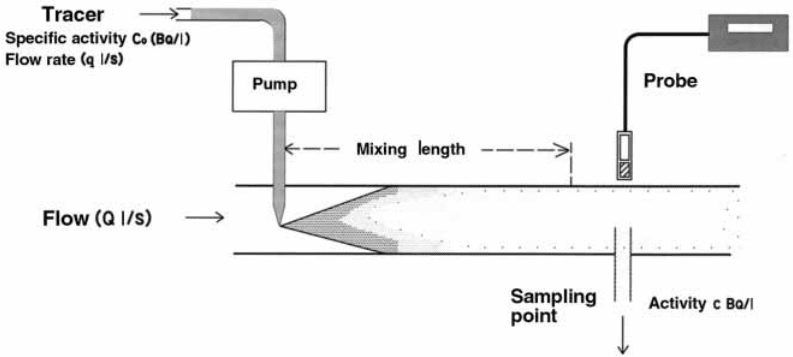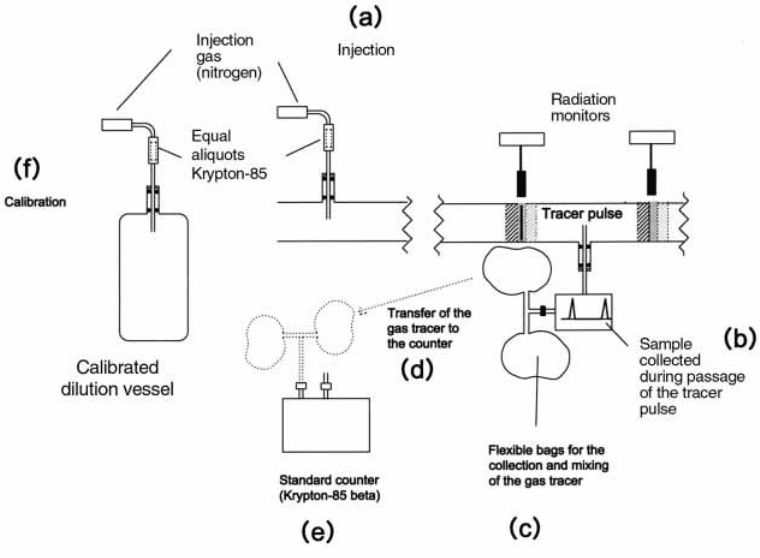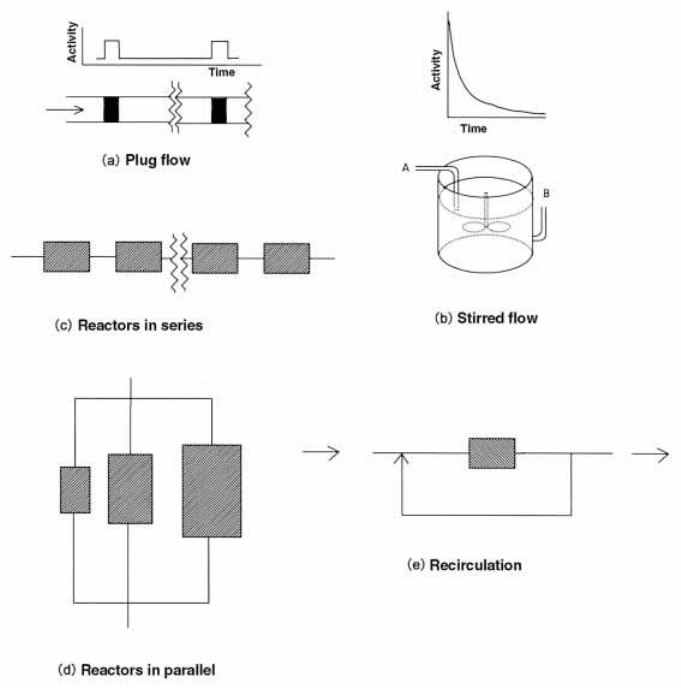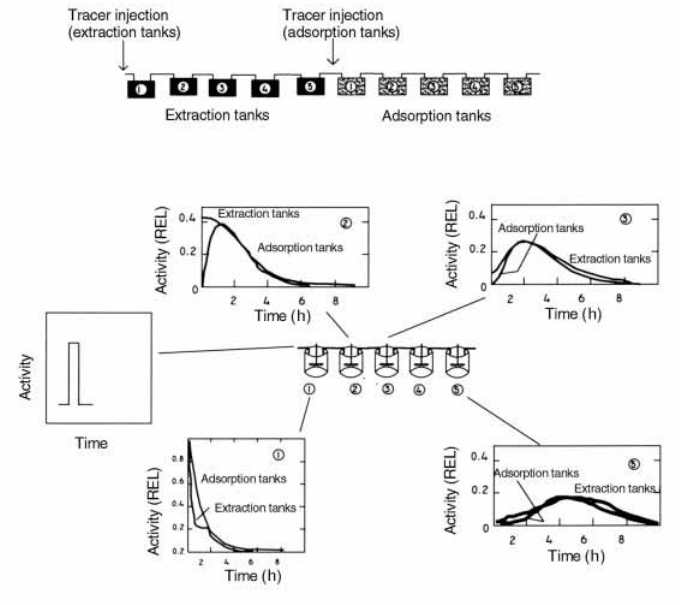Lowenthal G., Airey P. Practical Applications of Radioactivity and Nuclear Radiations
Подождите немного. Документ загружается.


Q qC
0
=c: (8.3)
Experimentally, it is only necessary to measure q and the activity ratio
C
0
/c. Absolute activities and therefore absolute detector ef®ciencies are not
required. For the most precise measurements, the activity ratios should be
close to unity. Signi®cant problems arise when the activity ratios exceed 10.
Readers are referred to the discussions of the total count method in Section
8.3.6 and the measurement of inventories in Section 8.4.4.
As with other tracer dilution methods, measurements at constant injection
rates are independent of the cross sectional area of the pipeline, assuming
complete mixing. However, as noted earlier, the total amount of tracer is
considerably greater than that required for the pulse dilution method
described below.
A detailed description of the tracer dilution method can be found in
Charlton (1986, Ch. 8). An example is provided of an industrial application
of the constant injection method. The aim of the study was to provide an
independent assessment of the accuracy of the dilution method as a basis for
calibrating ori®ce plate meters used for measuring the ¯ow rates of organic
liquids. For the purposes of the test, the liquid was metered from the stock
tank to a road tanker on a weigh bridge. The tracer was a completely miscible
Br-82 labelled (Table 8.1) par-dibromo benzene. Careful checks were made of
the constancy of the injection rate and of the stability of the counting system.
In the end it was found that the tracer dilution and the weighing method
8.3 Flow studies 251
Figure 8.4. Flow rate measurements: the continuous dilution method. The tracer is
injected at a constant rate and monito red after complete mixing has been achieved.
agreed to better than 1%, which is completely satisfactory as a basis for
secondary calibration and is a measure of what can be achieved with carefully
planned measurements.
8.3.5 Flow rate measurements: total sample method
Principle of the method
As indicated above, pulse dilution methods may be classi®ed into total
sample and total count methods. In the total sample method a tracer of
activity A (Bq) is injected into a pipeline or a river at position A (Figure 8.1)
as an instantaneous pulse and sampled at a constant accurately measured rate
q (l/s). The radiotracer HTO is commonly used for aqueous systems and
85
Kr
for gas ¯ow measurements. The sample is collected over an interval which
includes the passage of the whole pulse. The tracer activity in the sample is
measured (a Bq), and compared with the total injected activity. Assuming
complete mixing had been achieved at B, the total ¯ow rate Q (l/s) is given by
the simple expression (Appendix 4, Eq. (A4.9))
Q qA=a: (8.4)
Again, it is not necessary to measure absolute activities but only the activity
ratio. This considerably simpli®es the measurements as the absolute ef®cien-
cies of the detectors are not required. The measurement of river ¯ows using
the total sample method is outlined in Section 9.3.2. Gas ¯ow rate measure-
ments will be discussed below.
Case study: gas ¯ow rate measurement
The principle of the total sample method to the measurement of gas ¯ow
rates is illustrated in Figure 8.5. An accurately measured aliquot of tracer
85
Kr of activity A (Bq) from a stock supply is injected into the pipeline as a
pulse (Figure 8.5(a)) and sampled for a known time DT after complete mixing
was achieved (Figure 8.5(b)). As shown in the ®gure, the gas is collected into
two bags. The bags are isolated from the pipeline, their contents are
thoroughly mixed and then transferred into the chamber of the counter
(Figures 8.5(d) and (e)). The chamber is constructed with a plastic scintillant
and the b activity of the
85
Kr tracer is counted by a scintillation technique
(Section 5.4.2). The measured activity a (Bq) refers to the gas in the counting
chamber (volume v). Hence, the effective rate of sampling of the gas from the
pipeline q (l/s) into the counter is
Applications of tracer technology to industry and the environment252

q v=DT: (8.5)
Optimising accuracy
In principle, the gas ¯ow rate could be calculated from Eqs. (8.4) and (8.5) if
the activity ratio A/a and the counter volume v were known with suf®cient
accuracy. In practice, estimates of these parameters would introduce signi®-
cant errors. Fortunately the uncertainties may be greatly reduced by accu-
rately metering a second aliquot of the gas of equal activity A from the same
stock supply into a calibration vessel of volume V (Figure 8.5(f )). The
accurately diluted tracer is transferred from the calibration vessel to the same
counting chamber to determine its activity a
c
(Bq ). Hence a
c
/A is equal to the
dilution factor v/V, i.e.
8.3 Flow studies 253
Figure 8.5. Gas ¯ow using tracer dilution techniques. (a) Injection of an accurately
monitored aliquot of
85
Kr as an instantaneous pulse using high-pressure nitrogen.
(b) Collection of a sample of the gas containing the complete isotope pulse. This is
achieved by locating radiation detectors upstream and downstream of the sampling
point and monitoring the
85
Kr gamma emission. (c) The sample in¯ates the ¯exible
bags and is well mixed. (d), (e) The sample is transferred to the standard counter and
the activity registered. (f ) A second aliquot is added to a calibration vessel, mixed
and transferred to the standard counter.
A=a
c
V=v: (8.6)
Substituting the Eqs. (8.5) and (8.6) into Eq. (8.4) leads to the following
expression
Q a
c
=aV=DT: (8.7)
Gas ¯ow rates can be determined with precision as V and DT can be
accurately measured, and the scintillation counter is required only to measure
the ratio of the speci®c activities of the
85
Kr samples (a
c
/a) which are of
similar magnitude.
If required, the mass ¯ow W (kg/s) of the gas can be obtained from the
expression W = rQ where r is the density of the gas at ambient pressure in the
dilution vessel (Figure 8.5(f )) and not in the high-pressure pipeline. This is of
signi®cant practical advantage as the densities of gases, and especially of gas
mixtures, are not well known when at elevated pressures.
When this technique was employed for measurements in a natural gas
pipeline it produced results within 1% of those obtained with a reference
ori®ce plate (a standard calibration procedure), so illustrating achievable
accuracies, given suf®ciently careful procedures. The advantage of the tracer
method is that it can be readily applied away from installed calibration
facilities.
8.3.6 Flow rate measurements: total count method
The essential feature of the total count method is that ¯ow rate is determined
from the cumulative response of a strategically located detector. The detector
may be immersed in the liquid, e.g. for the gauging of rivers and streams, or it
may be located externally, e.g. when ¯ow rates are monitored in pipelines. In
either case the total number of counts N, corrected as required, is registered
during the passage of the complete pulse. It may be shown that the ¯ow rate
Q (l/s) is given by
Q AF =N (8.8)
where A (Bq) is the total injected activity and F (cps per Bq/l) is the
calibration factor relating the injected activity to the total number of counts
registered during the passage of the radioactive pulse (Appendix 4, Eq.
(A4.11)).
The application of the total count method to river ¯ow measurements is
described in Section 9.3.2. The calibration of fully immersed detectors
involves recording their responses (cps) to known tracer concentrations (Bq/l)
Applications of tracer technology to industry and the environment254
in a large tank (Figure 9.2(a)). When measuring ¯ow rates in pipelines, the
detector is placed external to the pipeline (Figure 9.2(c)). Calibration is
effected by setting up a section of similar pipeline and measuring the response
of the similarly located detector to a known activity of tracer within the pipe.
Care must be taken to ensure that the geometries of the ®eld measurement
and the calibration are as similar as possible.
8.3.7 Residence time distribution
The ef®ciency of many industrial processes depends on ensuring optimum
contact between the various reactants or between reactants and catalysts. If
contact times are too short, the reactions could be incomplete and the yields
of product reduced; if the contact times are longer than required, unwanted
secondary reactions could cause problems. Examples of processes where
contact times are important include:
catalytic conversions in the chemical and oil re®ning industries
leaching processes in the minerals extraction industry, and
the aerat ion of dispersed sewage in inland disposal ponds.
Radiotracer techniques have been widely used to assess the performance of
industrial plants against design speci®cations. In doing so, attention must be
paid to both the mixing processes and the residence time distributions
(RTDs) of the reagents and the tracers. The concept of the RTD was
introduced in Section 8.3.1 and is discussed in Section A4.7 of Appendix 4.
The mixing and transport of reagents and products through an industrial
plant are invariably complex. Detailed interpretation of the behaviour of the
tracer can often only be made with the aid of advanced computer modelling.
However, the experimental procedures can be illustrated using `plug ¯ow'
and `stirred ¯ow' approximations.
8.3.8 Residence time distribution: idealised plug ¯ow
Idealised plug ¯ow (Figure 8.6(a)) assumes a completely regular, steady ¯ow
through a pipe or channel. The principles have been applied to inland sewage
ponds which are designed to ensure that aeration processes can go to
completion without the need for mechanical mixing and with only negligible
dispersion. For plug ¯ow, the mean residence time (Section 8.3.1), MRT is a
measure of the time that components of the system remain in contact. It is
given by
MRT V=Q (8.9)
8.3 Flow studies 255

where V is the volume of the system and Q is the mean ¯ow rate.
The MRT of contact of the sewage with aerated water in a sewage pond
prior to release to the environment is one of the key design parameters. Plug
¯ow is normally maintained with a series of baf¯es. If a system develops
faults, a `short circuit' could occur when a part of the sewage by-passes one or
more of the baf¯e plates.
A pond with a design residence time of 24 hours was studied using the
radiotracers technetium-99m and tritium (HTO). Normally the tracer is
injected at the input of the pond and monitored at the output.
99m
Tc was
chosen because (a) it is a g ray emitter (E
g
= 140 keV) which can be
Applications of tracer technology to industry and the environment256
Figure 8.6. RTD under a range of ¯ow conditions. (a) Idealised plug ¯ow, and (b)
idealised stirred ¯ow showing the variation of activity with time following the
injection of a radiotracer pulse. (c) Reactors in series. (d) Reactors in parallel. (e)
Reactor with recir culation (feedback).
continuously recorded using immersed gamma ray probes; (b) it has a
conveniently short half life (6 h); and (c) it can be prepared in the ®eld by
elution from a
99
Mo/
99m
Tc generator (Section 1.5.2).
As the parent
99
Mo has a half life of 66 h, a number of
99m
Tc investigations
may be undertaken over a period of a week or more before the generator
needs replacing (Section 1.5.1). However, the use of
99m
Tc has the disadvan-
tage that it readily adsorbs onto the sewage particles and may therefore not
accurately re¯ect the transport of the aqueous component. Tritium as water
(HTO) was therefore added and samples collected periodically for laboratory
assay. By monitoring the HTO/
99m
Tc ratio, duly allowing for
99m
Tc decay,
any signi®cant differences in the transport of the sewage particles and the
water would be apparent.
In the present example, it was found that the ®rst evidence of tracer at the
outlet appeared not 24 hours after injection as expected but after only six
hours. In this case partially untreated sewage was being discharged to a river
system. A detailed analysis of the tracer response made it possible to arrive at
an engineered solution.
8.3.9 Residence time distribution: idealised stirred ¯ow
Stirred ¯ow
A schematic representation of a stirred ¯ow reactor is shown in Figure 8.6(b).
A single mixing tank operating continuously has both the liquid and, when
required, a radiotracer entering at A and leaving at B (see below). Stirring
must be very ef®cient since the mixing of the components is to occur almost
instantaneously. If a radiotracer (activity A Bq) is injected as a pulse into a
vessel of volume V, the initial concentration is C
0
= A/V (Appendix 4, Eq.
(A4.13)). In practice it is necessary to allow an adequate residence time for
chemical reactions to go to completion. To effect this it is common practice to
connect a number of stirred tanks in series. Mathematical expressions for the
RTDs are discussed in Appendix 4 (Eqs. (A4.15) to (A4.17)).
An example from the gold extraction industry
A tracer study was commissioned to investigate the lower than expected
yields in a gold extraction plant. The process was designed to extract gold
with an ef®ciency of 92 to 96% from ore with a gold loading of a few parts per
million (ppm). The plant comprises ten well stirred tanks in series. In the ®rst
®ve tanks gold is leached from the crushed ore with a solution of sodium
cyanide (0.02 to 0.05% NaCN). The second sequence of tanks contains a
8.3 Flow studies 257
slurry of activated charcoal onto which the gold precipitates at levels of 9 to
12 kg gold per metric ton of carbon. Finally, the gold is separated from the
carbon using concentrated alcoholic alkaline cyanide from which it is
recovered by electrolysis. The carbon is reused following its re-activation by
controlled roasting.
In the present case it was surmised that the reduction in the yield was due
to short circuiting of solution through one or the other of the sequences of
leaching or adsorption tanks. An investigation of the RTD of the aqueous
phase was therefore undertaken. The radiotracer tritium was used. Separate
studies were made of the performance of the adsorption and the leaching
tanks.
The adsorption tanks behaved as predicted. The tritium pro®les (shown in
Figure 8.7) closely re¯ected the mathematical expressions for the concentra-
tion pro®les for stirred tanks in sequence (Appendix 4, Eq. (A4.17)).
Independent estimates of the MRTs were obtained from the shapes of the
concentration pro®les and also from the tank volumes and the known ¯ow
rates (mean residence time = tank volume/¯ow rate through the tank). There
was good agreement between both estimates. Each indicated mean residence
times of about 90 min per tank. So far, so good.
However, the behaviour of the leaching tanks was very different. The
tritium concentration pro®le at the outlet of each tank is depicted in Figure
8.7. Clearly the system was exhibiting anomalous behaviour. The most direct
evidence for short circuiting was shown at the outlet of the second leaching
tank. A relatively slow build-up of tritium was expected. In practice, high
concentrations of the tracer appeared at the exit of tank 2 a few minutes after
being injected at the inlet of tank 1.
A similar behaviour was observed in subsequent tanks. It appeared that a
small fraction of the tracer was skimming across the surface of the leaching
tanks and not mixing with the bulk ¯ow. From a detailed analysis of the
pro®les it was concluded that about 16% of the ¯ow exhibited short circuiting
from tank 1 to tank 2, but the percentage decreased along the train.
The short circuiting was a likely reason for the reduction in yield of the
extraction process. The problem could be solved by either introducing a sixth
tank into the leaching train or, if practical, increasing the ef®ciency of mixing.
8.3.10 A comment on modelling complex ¯ows
Flow patterns in chemical reactors are normally far too complex to be
represented by plug ¯ow or stirred ¯ow approximations. In practice, there are
two approaches to more realistic modelling. The ®rst involves analysis of the
Applications of tracer technology to industry and the environment258

¯ow patterns in terms of a number of plug ¯ow or stirred ¯ow elements which
may either be in series or in parallel and may involve feedback circuits. The
various elements are shown schematically in Figures 8.6(c), (d) and (e). The
second approach involves the holistic modelling of the ¯ow patterns using
computer ¯uid dynamic (CFD) codes. The use of these codes presents new
challenges and opportunities for tracer technology as a powerful method for
experimental validation of the model output. However, detailed discussion is
beyond the scope of this book.
8.3 Flow studies 259
Figure 8.7. RTD study in the gold extraction industry. A sequence of ®ve extrac-
tion tanks and ®ve adsorption tanks in series. An instantaneous pulse of tritium is
injected at the inlet to the ®rst extraction and to the ®rst adsorption tank. The tritium
concentrations after the ®rst, the second, the third and the ®fth tanks are shown
graphically as a function of sampling times. The pro®les in tank 4 may be inferred
from those in 3 and 5. The extraction and adsorption tanks show signi®cantly
different behaviour.
8.4 Industrial applications of tracers: case studies
8.4.1 Introduction
The range of applications of radiotracing to industry is indicated in Table 8.3.
Three examples have been selected to illustrate the diversity of investigations
which may be undertaken with the help of radiotracers. The studies are
¯uidised catalytic cracking in oil re®neries, an example of the use of radio-
tracers in blast furnaces, and the monitoring of industrial inventories of
mercury; each is now described in turn.
8.4.2 Fluidised catalytic cracking unit
Oil re®neries are designed to convert crude petroleum to fuel, heating oil,
lubrication products and feedstocks for the petrochemical industry. Radio-
isotope techniques have been widely used for:
. the calibration of ¯ow rate measurement systems (Section 8.3.2);
. the examination of pipelines on the surface, underground or sub -sea to detect the
build-up of deposits and locate blockages or leakage;
. the scanning of distillation columns (Section 7.2.1);
. the optimisation of a range of catalytic processes.
Catalysts are used in the re®ning industry for: (a) catalytic cracking, i.e. the
production of gasoline range hydrocarbons from the higher boiling fractions
of crude oil; (b) isomerisation i.e. the conversion of low octane C
5
and C
6
n-
paraf®ns into higher octane branched isomers; (c) reforming, i.e. the conver-
sion of C
6
+ aliphatic hydrocarbons to aromatics and branched chain hydro-
carbons and thus increasing the octane number of the naptha feedstock; and
d) for a range of processes in the petrochemical industry.
This section will brie¯y describe applications of radiotracing to ¯uidised
catalytic cracking, a process that is central to the operation of modern
petroleum gasoline re®neries. In United States re®neries, the amount of feed
processed by ¯uidised catalytic cracking units (FCCUs) was, in 1991,
equivalent to 35% of the total crude oil processed. A schematic representation
of an FCCU is shown in Figure 8.8.
It is critical to the economics of the re®nery that FCCUs operate to peak
speci®cation. Investigations are complex because there are four major process
streams which come together to effect the catalytic cracking reactions: fresh
feed, catalyst, steam and air. Radiotracer techniques offer a uniquely
Applications of tracer technology to industry and the environment260
